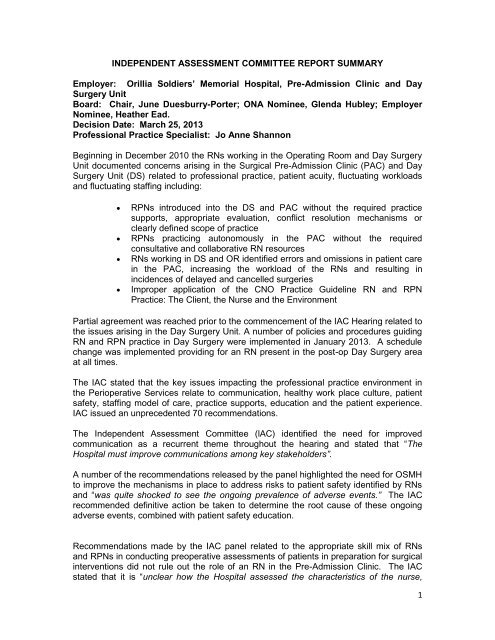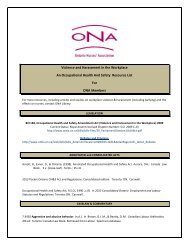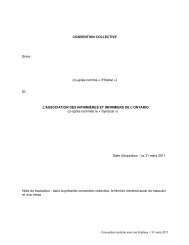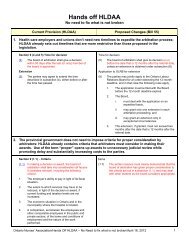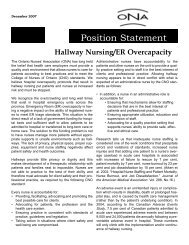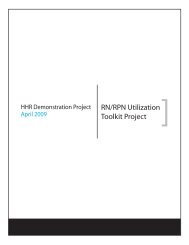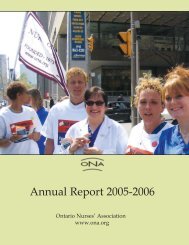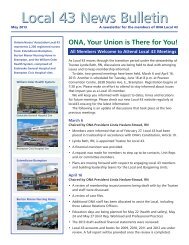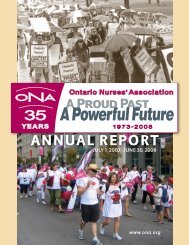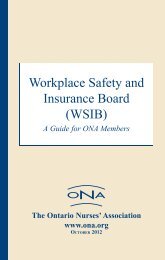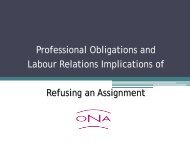Independent Assessment Committee Summary - Orillia Soldiers
Independent Assessment Committee Summary - Orillia Soldiers
Independent Assessment Committee Summary - Orillia Soldiers
- No tags were found...
You also want an ePaper? Increase the reach of your titles
YUMPU automatically turns print PDFs into web optimized ePapers that Google loves.
INDEPENDENT ASSESSMENT COMMITTEE REPORT SUMMARYEmployer: <strong>Orillia</strong> <strong>Soldiers</strong>’ Memorial Hospital, Pre-Admission Clinic and DaySurgery UnitBoard: Chair, June Duesburry-Porter; ONA Nominee, Glenda Hubley; EmployerNominee, Heather Ead.Decision Date: March 25, 2013Professional Practice Specialist: Jo Anne ShannonBeginning in December 2010 the RNs working in the Operating Room and Day SurgeryUnit documented concerns arising in the Surgical Pre-Admission Clinic (PAC) and DaySurgery Unit (DS) related to professional practice, patient acuity, fluctuating workloadsand fluctuating staffing including:RPNs introduced into the DS and PAC without the required practicesupports, appropriate evaluation, conflict resolution mechanisms orclearly defined scope of practiceRPNs practicing autonomously in the PAC without the requiredconsultative and collaborative RN resourcesRNs working in DS and OR identified errors and omissions in patient carein the PAC, increasing the workload of the RNs and resulting inincidences of delayed and cancelled surgeriesImproper application of the CNO Practice Guideline RN and RPNPractice: The Client, the Nurse and the EnvironmentPartial agreement was reached prior to the commencement of the IAC Hearing related tothe issues arising in the Day Surgery Unit. A number of policies and procedures guidingRN and RPN practice in Day Surgery were implemented in January 2013. A schedulechange was implemented providing for an RN present in the post-op Day Surgery areaat all times.The IAC stated that the key issues impacting the professional practice environment inthe Perioperative Services relate to communication, healthy work place culture, patientsafety, staffing model of care, practice supports, education and the patient experience.IAC issued an unprecedented 70 recommendations.The <strong>Independent</strong> <strong>Assessment</strong> <strong>Committee</strong> (lAC) identified the need for improvedcommunication as a recurrent theme throughout the hearing and stated that “TheHospital must improve communications among key stakeholders”.A number of the recommendations released by the panel highlighted the need for OSMHto improve the mechanisms in place to address risks to patient safety identified by RNsand “was quite shocked to see the ongoing prevalence of adverse events.” The IACrecommended definitive action be taken to determine the root cause of these ongoingadverse events, combined with patient safety education.Recommendations made by the IAC panel related to the appropriate skill mix of RNsand RPNs in conducting preoperative assessments of patients in preparation for surgicalinterventions did not rule out the role of an RN in the Pre-Admission Clinic. The IACstated that it is “unclear how the Hospital assessed the characteristics of the nurse,1
client population and environment prior to implementing the change in skill mix in preassessment.”The IAC recommended a comprehensive evaluation be initiated withinthree months related to the change in nursing skill mix taking into account metrics thatinclude surgical delays and cancellations, adverse events and near misses and patientsatisfaction. “Unless the practice environment and its respective supports substantiallyincrease having an RN present in the Pre admission clinic may be beneficial.”The IAC did fail to reach consensus on the issue of the nursing skill mix, and the ONANominee issued a dissent which can be found in Appendix 5 of the report, and is alsoattached separately to this summary. Attached to ONA’s dissent is a letter from thePresident of the National Association of PeriAnesthesia Nurses (NAPAN©) titled RPNsin the PreAdmission Unit: NAPAN©’s Position.The letter from NAPAN© to the IAC clearly states that it seems unreasonable to considerthe RPN for a role in the Pre-Admission Clinic. Further, NAPAN© states that there is awealth of qualitative and quantitative evidence supporting the autonomous role of the RNin the PAC, and it would not be best practice to include RPNs in this unit. NAPAN©conducted a literature review and “could find nothing which points to the R/LPN role inPAU or other ambulatory setting. There is no evidence-based research to support theR/LPN role showing improvement in client outcomes. The opposite is the case:increased surgical cancellations, missed information, and increased hospital admissionsfollowing surgery. It seems unlikely that NAPAN© will revise the standards torecommend that this role will now be taken on by R/LPNs who do not have the educationor assessment skills to perform the kind of in-depth assessment required of thePeriAnesthesia nurse”.Throughout the report, the expert panel’s recommendations clearly identify theinadequacy of existing policies and current clinical and administrative supports to ensurethat nurses can provide the best possible patient experience as per the College ofNurses of Ontario Standards of Practice. The panel recommended numerous policyrevisions, changes to existing documentation and improved accessibility of RNs tosupport and collaborate with RPNs during the assessments conducted prior to surgery.The Union looks forward to working with the Hospital to achieve these recommendationswhich the IAC stated “will have a cascading effect of improving the quality of patientcare, nursing workload, and the RN staff working environment.”2
INDEPENDENT ASSESSMENT COMMITTEE RECOMMENDATIONSCOMMUNICATIONRecommendation 1: The Hospital must improve communications among keystakeholdersThe <strong>Independent</strong> <strong>Assessment</strong> <strong>Committee</strong> (lAC) identified the need for improvedcommunication as a recurrent theme throughout the hearing.Recommendation 2: The hospital needs to respond to RiskMonitorPro (RMP)concerns raised by nurses within 28 calendar daysTimely resolution and closure of issues provides nurses with the reassurance that theirissues are taken seriously.Recommendation 3: RNs and the Hospital adherence to Article 8 reportingprocessA review of the intended process of completing work load incident reports should beshared with staff and managers.Recommendation 4: Utilize methods of communication that match the intended orrequired outcome.PATIENT SAFETYRisk Monitor ProRisk Monitor Pro captures both adverse events and safe catches. The employer reliedon their analysis of events pre and post skill mix change which they stated showed nodifference in the number or types of errors documented. The IAC found that the datarelied on by the employer generated from the Risk Monitor Pro incident reporting systemwas noted to be flawed. Inconsistencies and anomalies were present in the reports andin the Hospital's analysis report.Recommendation 5: Communication must be transparent in that the RMP reportsneed to be shared with staff on a regular basis in their totality. Targeted analysisand reports are to be shared and need to be inclusive of the scope and orlimitations of the report.Recommendation 6: The Hospital should respond to substantive RMPs raised bynurses within 28 calendar daysRecommendation 7: Provide patient safety education to aIl the pre-admission, daysurgery and operating room staff.The lAC strongly believes that through the provision of Patient Safety education to thestaff there would facilitate a common understanding of what constitutes a safe catch(near miss), specifically the importance of reporting same for the purpose of learning asopposed to the assignment of blame.Recommendation 8: Need to reframe the constructive nature and purpose ofRMPs to promote the quality practice settingsThere is an opportunity to better utilize Risk Monitor Pro as a tool to leverage qualityimprovement, team building and communication across the organization; e.g. the large3
number of errors around obtaining consent can be used to increase awareness ofnurses of the consent act and internal policy.1. Reframe the completion of a RMP as a staff member's personal contribution toachieving patient safety;2. Learning plans should be generated where recurrent errors/incidents arereported.Recommendation 9: Use the Professional Responsibility Workload Report Forms(PRWLFs) to serve as a source of learning needs when directly linked to a RMPThe lAC encourages the hospital and the Association to utilize the ProfessionalResponsibly Workload Report Forms (PRWLFS) as a source of data and opportunitiesfor learning and identification of knowledge gaps.Recommendation 10: Identify system and process issues by means of a failuremodes analysis (FMA) should be completed from surgeon consult, to PAC, DSU,OR, PACU, DSU, and home discharge.The lAC heard that there were ongoing concerns regarding the nature and volume ofRMPs. Spherically, those related to medication errors, consent, missed laboratory tests,patient identification, and correct site surgery to name a few. Regardless of the changein skill mix the lAC was actually quite shocked to see the ongoing prevalence of adverseevents.Recommendation 11: Need to reassess the effectiveness of the visual cuingutilized for classifying preadmission chartsRecommendations 12-16: The lAC recommends by the end of 2013 the followingbe implemented:12. The Hospital develop a policy and corresponding procedure to support theimplementation of the Surgical Safety Checklist detailing expected outcomes,responsibilities and actions, similar to the Hospital's policy Universal Standard ofCare for Preventing Wrong Site, Wrong Procedure, Wrong Person Surgery:Operating Room.13. The Hospital's policy Universal Standard of Care for Preventing Wrong Site,Wrong Procedure, Wrong Person Surgery: Operating Room be amended to beinclusive of stating when and where surgical site markings are to occur.14. The Hospital's policy (Universal Standard of Care fore Preventing Wrong Site,Wrong Procedure, Wrong Person Surgery: Operating Room and Surgical SafetyChecklist Policy) will endorse a consistent communication process/tool whentransferring a patient from one health care provider to another health careprovider i.e. SBAR, CHAT (CHECK?) TOA (transfer of accountability).15. The Hospital's Surgical Safety Check list content be appropriately embeddedin the patient record in accordance with the requirements of Health Records andthe respective regulatory colleges of the health care professionals involved in theoverall process.16. The Hospital's Surgical Safety Check list or SBAR tool etc. be amended to beinclusive of a record of the last dose of intravenous sedation or analgesic givenand or intravenous reversal agent give if the patient is being fast tracked (bypassPACU).4
Recommendation 17: Within three (3) months establish an evaluation frameworkinclusive of measurements, targets and reporting timeframes appropriate for themeasurement and target.The lAC heard that the change in skill mix had not benefited from an evaluationframework inclusive of measurement, targets and reporting timeframes. The lACrecommends that the Peri operative program establish clear targets on metrics within anevaluation framework inclusive of:• Surgical cancellations• Surgical delays• Surgical late starts• Errors regarding consents• Absence, missed labeled specimens• Positive patient identification compliance• Safety surgical checklist compliance• Patient satisfaction• Adverse events and safe catchesSTAFFING MODELRecommendation 18: Regarding the Three-Factor Model in PAC: Further delineatethe pre admission needs of the patient population the Hospital serves and indoing so the lAC does not rule out a role of the RN in PAC over and above that ofhaving a Resource Nurse in DSU available to the RPN for consultationThe lAC stated that it remains unclear how the Hospital assessed the characteristics ofthe nurse, client population and environment prior to implementing the change in skillmix introduced in pre-assessment. Further, what can be unknown is the well-definednature of the patient’s health care education/teaching needs, coping mechanisms andsupports in place in the context of their pending surgery:• Their knowledge of the impact of the pending surgery on pre-existing conditions;• Subtle signs and symptoms of underlying co-morbidities which may be difficult todetect;• The necessary supports which need to be in place post discharge.ONA’s dissent recommended that the nursing staffing model in the OSMH Pre-Admission Clinic should be two (2) Registered Nurses. ONA’s nominee found thatrecommendation #18 is weak, vague and supported by insufficient evidence; and doesnot address the issues and nursing care and practice concerns presented to the IAC inany meaningful way. Further, she concluded that her IAC colleagues have notconsidered nor provided her with documented evidence based on best practices tosupport their recommendation related to the nursing staffing model in the PAC.Recommendation 19: The Hospitals' resources that support quality patient care inthe perioperative services need to be more robust. There are gaps inpolicies/procedures which are necessary to support consistency and bestpractices in care. Some examples include:1. The Discharge from PACU policy should be updated to include oxygensaturation, sensory and pain level (section 29, exhibit 1). There should be apolicy developed for care of the patient with Obstructive Sleep Apnea(OSA) to guide care of patients with suspect or confirmed OSA.5
2. Preoperative orders should be completed by the surgeon based on anindividualized assessment with consideration being given to theinvasiveness of surgery, age of patient, comorbidities, family supports,proximity to hospital, etc. to ensure an individualized assessment.3. Documentation tools (PACU and DS record) are dated and needing revision(there are 2 different assessment forms to be merged to one form) seeRecommendations 35 and 36.The IAC stated that it has taken two (2) years to update the consent policy, and anothersubsequent two (2) years to roll out the change which reflects a total timeline of four (4)years. Timelines need to be significantly shorter to enable the implementation of efficientand sustainable changes.Role ClarityRecommendation 20: Preoperative requirements should be undertaken by aregulated health care professional in PAC. Alternatively, a preprinted order setcould be completed by the surgeon at the same time informed consent is provided(patient sign off/verification can be done at preoperative clinic).The IAC found that here appears to be too much dependence upon the clerk in PAC toassess the patient's need for laboratory work and consults. This piece of work should beremoved from the clerk's duties, and be taken over by regulated healthcare staff in thePAC. The preoperative requirements policy should not be initiated or triggered by theclerk.Recommendation 21: Review policies, medical directives and the respective roleand scope of practice of all staff within PAC inclusive of the RN Resource NurseThe policies, medical directives and scope of the clerk, RPN, RN need to be clearlyoutlined and reviewed with staff. “Unless the practice environment and its respectivesupports substantial increase having a RN present in the Pre admission clinic may bebeneficial.”HEALTHY WORKPLACE CULTURERecommendation 22 - 27: The lAC recommends the following regarding anensuring compliance with the Hospital's Code of Conduct and WorkplaceHarassment Bullying/Violence22. Immediately: Chief of the Perioperative program review and reinforce with allphysician the Hospital's policy-Code of Conduct and Workplace HarassmentBullying/Violence and confirm to the perioperative surgery meetings that thisaction has taken place.23. Immediately: The Manager and enforce with all Nursing groups and AlliedHealth the hospital's policy - Code of Conduct and Workplace HarassmentBullying/Violence and reinforce with all staff the Hospital's policy-Code ofConduct and Workplace Harassment Bullying/Violence and confirm to theperioperative surgery meetings that this action has taken place.24. The Hospital's policy (Code of Conduct Implementation Process & WorkplaceHarassment Bullying/Violence) be added to the Competency skills checklistAnnual Review document (See Recommendation 49).25. The Hospital's policy (Code of Conduct Implementation Process & WorkplaceHarassment Bulling/Violence) would benefit from be added to the MedicalAdvisory <strong>Committee</strong> (MAC) agenda to promote ongoing awareness.6
26. Provide mandatory education sessions to the Peri Anesthesia/Operativenurses on:• Workplace Harassment• Assertiveness training• Communication SkillsThe lAC suggest that the College of Nurses be considered as a potential fordelivery of this education27. The lAC strongly recommend that the Hospital and Association work incollaboration to implement the recommendations arising from the Mediation heldon January 26th 2013 by an external facilitator. The lAC would further recommendthat all staff support and recognize the value in being a full and active participantin the implementation process.Recommendation 28: Leverage the College of Nurses Quality Assurance programto promote a respectful work environment by modeling professional behavioursThe lAC strongly recommend that the nurses within the Perioperative Programcollectively choose the Conflict Management Practice Guideline and ProfessionalStandards, revised (2002) to review for one of their learning goals for the purpose ofpromoting a respectful work environment by modeling professional behaviours.Recommendation 29: Improve accessibility of PAC RPN to DS RN (resourcenurse); employ voicera system used in PACU and DSU, rounding by manager toPAC during day to confirm no concerns, regular staff meetings and follow-up).The lAC was concerned that the Day Surgery RNs who assume the role of ResourceNurse for the RPNs in the PAC do not receive calls for collaboration from RPNs in PAC.While the lAC could accept that calls may not be required on an hourly or even dailybasis, the total absence of calls was seen as of concern in the context of patient care.CHANGE MANAGEMENTThe lAC saw limited use of a formalized change management model underpinning theintroduction of the new model of care.Recommendation 30: Communicate and utilize a formalized Change ManagementFrameworkWhen there is to be a change in model of care and or skill mix it should be approachedas a method of organizational change which requires careful planning, communication,implementation and evaluation if it is to achieve its intended objectives.SUPPORTING THE CHANGE PROCESSRecommendation 31: Clinical and administrative supports to facilitate thenecessary changesThe lAC recognizes that the relevant members of the Hospital and the Association Perioperative Program have recently undergone externally facilitated mediation. Theundertaking of this process in the context of a pending lAC is indicative of a veryunhealthy work place culture and certainly not one in which change and professionalpractice would readily be expected to flourish.7
Organizations often do not always have processes in place to support nurses through asystematic approach for developing, implementing and evaluating nursing interventions,protocols, critical pathways, and policies.The lAC strongly feel that there needs to be supports put in place to achieve thenecessary changes in the Peri operative Services and they include:• Professional Practice Coordinator dedicated for a minimum of 3 days per week x6 months to assist with policy, process and form revisions, implementation andevaluation• Dedicated support from the Performance Excellence, a corporate resource teamto lead and support the recommended quality improvement opportunities• Patient Safety Risk Management Coordinator support in undertaking FMAs toidentify and solution underlying inherent system issues• Hospital support for the identification of unit champions to lead and sustain bestpracticeMentorshipMentorship is central to a successful transition of new and also experienced nurses intonew areas and or ways of working.Recommendation 32: Immediately identify unit champions who can providementorship and support to the implementation of the new consent policy, andother initiatives be they RNs or RPNs. Over the next 12-18 months develop andformalize a Mentorship Program for the purpose of synthesizing the key elementsfor mentors and mentees in the PerioperativejAnesthesia Program, implement andevaluate.Recommendation 33: Within six (6) months the Hospital implements an interdisciplinaryPractice Council within the perioperative program.The lAC strongly feel that this will serve as a mechanism for discussion of and resolutionof issues relating to operational functioning and clinical practice issues related to theprovisions of patient care within the perioperative program. Suggested Terms ofReference were included.The lAC believes that the skill mix changes would have had a greater change ofsuccessful implementation if it had been approached from a change managementperspective that involved the RNs in the decision, helped them to understand thatsimilar fiscal/resource challenges are being experienced in otherperioperative/anesthesia units throughout the province. There appeared to be noengagement of the individuals most impacted (the RNs) by the skill-mix change inDay Surgery.Celebrating SuccessRecommendation 34: Develop and action daily ways of recognizing andcelebrating of success however smallPATIENT FLOWTransfer of Accountability (TOA)The lAC noted gaps around 'transfer of accountability' (TOA) and therefore have thefollowing recommendations which the lAC feels will positively impact RN workload.8
Recommendation 35: The lAC supports the Hospital's intention to revise andupdate the documentation form used by the PACU RNs.Recommendation 36: The lAC supports the Hospital's intention to revise andupdate the documentation form used by the DSU nurses.Recommendation 37: The lAC strongly recommends that the documentation formused by the anaesthesiologists revise and updated.Recommendations 38-41:38. In the absence of a clear and consistent transfer of care communication thelAC does not support the current practice of fast tracking of patients to DSU39. The Fast Track - Bypassing PACU Phase I - II policy makes reference to theOPANA position statement 7. The lAC strongly feels that the policy not be limitedto the position statement but also be inclusive of the OPANA guidelines ascontained on pages 220-221 6th edition immediately. In the absence of this thelAC does not support the current practice of fast tracking of patients to DSU40. Ensure all nurses in Phase II (Day Surgery) are competent to handle anyunexpected outcomes (Cardio/Respiratory) that may be a direct result of fasttrackinga patient41. The lAC encourages the Hospital and Association to collaboratively exploreways of encouraging and promoting RNs to enhance their professionaldevelopment and undertake further educational opportunities such as CNAcertification. The lAC also strongly encourages the Hospital to explore jointprofessional development opportunities with other healthcareproviders/organizations within their LHINThe lAC believes that the RNs in perioperative program should move forward toobtaining their Canadian Nurses Association Certification.Day Surgery (Phase II Recovery) Schedule / Staffing Supportive of Patient FlowRecommendation 42: Change the 0830 start time to a 0800 start time to ensure aRN is available when patient(s) are being fast tracked to arrive in DSU prior to0830, otherwise the patient should remain under the care of a RN from PACU untilthe 0830 RN arrives.Recommendation 43: The Hospital undertake a review with active participation bythe staff to identify the profile (i.e. nature and characteristics) of the patientpopulation in DSU between 1630 – 1900 hours by day of week to identify andmatch the appropriate RN:The review may include the following:a. Volume of patientsb. Average and median LOS post 1630 hoursc. Nature of surgeryd. Reasons for delayed discharge up to and beyond 1900 hourse. Admissions to DSU from the 'Emergency List'f. Decisions to admitThere are times in day where one RN is staffed in Day Surgery, this is unsafe. A secondindividual should be staffed between 1730-1900 in the absence of a review of the patientpopulation in DSU between 1630 - 1900 hours.9
Recommendation 44: Advance the start time of the early RN to ensure coverage ofFast Track patients into DSUIn the event changes to the start time of the RN is not possible the lAC stronglyrecommends that patients eligible for 'fast tracked' remain in PACU until the RN arrivesat 0830 in the DSU.Recommendation 45: Assigning location of patients to support safety and comfortAny patient who has received sedation should not be left in hall unobserved by ananesthesiologist or nurse while awaiting transfer back to day surgery.PROFESSIONAL PRACTICE SUPPORTSIt is imperative that the Hospital provide practice supports which include clear andidentified procedures, policies, medical directives, protocols, plans of care, carepathways and assessment tools appropriate to the patient population who access care.Recommendation 46: Orientation and ongoing support of continued educationand learningPERI-OPERATIVE SELF ASSESSMENT COMPETENCY/SKILLS CHECK LISTRecommendations 47- 48: Within 3 months have reviewed and revised the NursingSkill Competency Checklists Tool for the following perioperative nursing roles toensure that it is fully comprehensive. The lAC feel strongly that all staff undertaketo annual review and sign off their personal checklist. The Nursing SkillCompetency ChecklistsTool (NSCC) should be reviewed annually and prior to anynew hire into the appropriate role/department.47. The Unit Competency Skills Checklists will include but not be limited to:• Core competencies• Surgical subspecialties competencies(Orthopedics/ENT/GeneraVUrology/etc) that nurses will work in• New/revised annual policies, protocols, medical directives• The individual staff learning plans flow from the completion of the checklistthemselves and are to be supported by the mentorship program andeducation as required48. All new hires to the perioperative services must demonstrate the requiredknowledge base and associated competencies using a range 'of evaluationmethods prior to commencement of autonomous practice.Recommendation 49: Enhance the specific competency skills check lists used tobe inclusive of more specific and measurable outcomesa) Enhance the competency skills check list used in the PACb) Enhance the competency skiffs check list used in the Day Surgery Unite.g. demonstrates understanding of the CNO practice guidelines (Directives, Consent,Working with Unregulated Healthcare Providers, etc), through completion of a writtentest linked to case studies, and/or the CNO on-line learning modules.Link to the competency checklists of all nursing staff within perianesthesia and perioperative departments a written test on department-relevant scenarios that examine theCNO Practice Guideline "The RN and RPN Practice: The Client, the Nurse and theEnvironment".c) Provide a forum/venue where staff can provide input and suggestions forcurrent and future learning needs.10
Recommendation 50: Develop with a sense of urgency and implement a policyrenewal program for the Perioperative ServicesAs noted by the CNO, work place environments should have the appropriate resourcesto support RPN and RNs practice such as "support tools (for example, assessment tools,protocols and policies); and clear role descriptions and responsibilities of care providers(RPN, RN and unregulated care provider)". Further, the RPN should have access to aRN for consultation/clarification as needed.To assist with policy renewal the IAC recommended that the Hospital should initially startwith the following policies referenced in recommendations 51 – 63:Recommendation 51: Update 'Discharge Policy from PACU'As part of the policy clearly outlines situations where the PACU RN must ensure thattransfer of accountability in Phase II recovery is to be to a RN and when the transfer ofaccountability can be given to a RN/RPN.Recommendation 52: Update The Admission Criteria for Day Surgery RecoveryPolicyRecommendation 53: Update 'Fast Tracking - Bypassing PACU Phase I to Phase II'Recommendation 54: Update 'Pre-Admission Clinic Patient Standard of Care'Recommendation 55: Update the protocol Tests Performed Preoperatively forSurgeryRecommendation 56: The policy Transfer of Patient from Recovery room to DaySurgery Unit' must be revisedRecommendation 57: The policy "Guidelines for Transfer of Care" must berevised.Recommendation 58: The policy "Guidelines for Anesthetic Consults" must berevisedRecommendation 59: The policy "Day Surgery Postoperative Routine and ScoringGuidelines" must be revisedRecommendation 60: A policy for "Criteria for Same Day Surgery" must bedevelopedDOCUMENTATIONRecommendation 61: Revise the preoperative checklist.Recommendation 62: Amalgamate the preoperative questionnaire for In-patentadmissions and DSU patientsRecommendation 63: Revise the "Anesthetic Questionnaire for Nursing<strong>Assessment</strong>" form11
STAFF PROFESSIONAL DEVELOPMENTSelf <strong>Assessment</strong> Competency/Skills Checklist (Peri-Operative/Anesthesia Departments):Recommendations 64-65:64. Within 3 months have reviewed and revised the Nursing Skill CompetencyChecklists/Tool for the following Peri-Operative / Anesthesia nursing roles toensure that it is fully comprehensive. The lAC feel strongly that all staff undertaketo annual review and sign off their personal checklist. The NSCC should bereviewed annually and prior to any new hire into the appropriate role/department.i. Scrub Nurse (Operating Room)ii. Circulating Nurse (Operating Room)iii. Endoscopy Unitiv. Post Op Anesthetic Care Unit (PACU)v. Pre-<strong>Assessment</strong> Clinicvi. Day Surgery/Phase II Recovery65. The Unit Competency Skills Checklists will include but not be limited to:i. Core competenciesii. Surgical subspecialties competencies(Orthopedics/ENT/Genera/Urology/etc) that nurses will work iniii. New/revised annual policies, protocols, medical directivesiv. The individual staff learning plans flow from the completion of the checklistthemselves and are to be supported by the mentorship program andeducation as required66. All new hires to the Peri-anesthesia/operative program must demonstrate therequired knowledge base and associated competencies using a range ofevaluation methods prior to commencement of autonomous practice.PATIENT EXPERIENCERecommendation 67: Need to frame the perioperative experience from the patientperspectiveRecommendation 68: Create opportunities for nurses to job shadow in other areasRecommendation 69: Increase the awareness of the individual units within theperioperative services to the overall patient care experience by creatingopportunities for nurses to job shadow in other areasRecommendation 70: Standardized pre and post-operative patient informationPart IV SUMMARY and CONCLUSIONSThe lAC encourages the Hospital and the Association to work together to achieve theserecommendations, and to make effective use of data to evaluate their progress andleverage the ability to learn and adjust as appropriate along the way. “The lAC stronglybelieves that the process of implementing these recommendations will have a verypositive impact on the relationship between the Hospital and the RN staff of both the Perioperative Services which will have a cascading effect of improving the quality of thepatient care, nursing workload, and the RN staff working environment.”12


